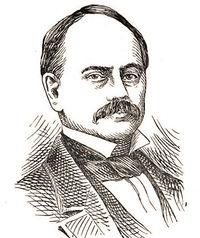Annotation:Dixie
X:1 T:Dixie’s Land M:2/4 L:1/8 S:Anonymous 1862 American music manuscript collection (p. 7) N: https://archive.org/stream/MerryMen/MUMSS-00079#page/n0/mode/2up Z:AK/Fiddler’s Companion K:D (A/F/)|DD (D/E/F/G/)|AAAF|BBB>A|(B>A) (B/c/d/e/)|f3 (d/B/)|d3 (A/F/)|A3 E/F/|D3:| |:(3A/B/c/|B d2B|e3B|e3 (3A/B/c/|dfe>d|Bcd>B|AFdF|F E2F| D3F|E3B|AF d>f|ed2 F|D3F|E3B|AF f>d|e d3!D.C.!:|]
DIXIE. American, Air or March (2/4 time). D Major (Phillips): G Major (Mattson & Walz, Sweet): C Major (Person). Standard tuning (fiddle). AAB (Person, Sweet): AABB (Mattson & Walz): AABB' (Phillips). Composition of the tune is usually credited to 19th century black-face minstrel Daniel Decatur Emmett, however, Howard and Judith Rose Sacks in their 1993 book Way Up North in Dixie (Smithsonian Institution Press) make a compelling case for its origin within the African-American community. Their thesis is that it was a black folk song taught to Emmett by African-Americans Ben and Lew Snowdon, fiddler, banjoist and entertainers from Emmett's home town, Mt. Vernon, Ohio. Another plausible explanation the Sacks report is that the tune derived from a collaborative process in the friendship and musical cross-fertilization of the Snowden family and Dan Emmett. Though the exact date of composition is unknown, the melody appears listed in a playbill of April 4, 1859 for a performance of Bryant's Minstrels in New York City, which predates its first Southern performance in New Orleans on April 9, 1860 (at the Varieties Theater, performed in a march and drill routine by forty female performers dressed as Zouaves). In a program from a later performance by Bryant's Minstrels (1861) it is explained that "As many inquiries have been made in regard to the meaning of 'Dixie Land', and as to its location, it may be well to remark that, with the Southern Negroes, Dixie Land is but another name for home" (Fuld, 1966). Regarding the origin of the word 'Dixie', Fuld speculates that it is of English origin as it is a family name dating back to the 14th century or earlier, some of whose members emigrated to both the Massachusetts and Carolina colonies as far back as 1629 (in the first great migration from England, mostly of East Anglia Puritans). See Fuld, The Book of World-Famous Music, 1966/1971, pp. 196–199 for a comprehensive discussion of the early printing history of the tune. Whatever its origins, it is inextricably credited to Dan Emmett. When the old minstrel died in 1904 in Mt. Vernon (Ohio), a band played several hymns at his gravesite. The last tune, as his casket was being lowered, was "Dixie."

The tune became fused with the secessionist cause in the American Civil War, to the extent that over one hundred years later it was banned in a number of schools in deference to African-American students who felt that it still carried racist associations. It was played at the inauguration of Confederate President Jefferson Davis in 1861, which indicates the rapid dissemination of the melody as a symbol of Southern pride. Having been popularized during that 19th century conflict, it was disseminated into tradition through discharged soldiers (Cauthen, 1990) and could be regularly heard throughout the South for many decades following that conflict. It was, for example, in the repertory of Alabama fiddler D. Dix Hollis and Civil War fiddler Ben Smith (a Georgian in the Twelfth Alabama Regiment), among other citations of the tune in Alabama by Cauthen (1990). The old Raleigh News and Observer (Sept. 4, 1910) records the tune as being in the repertoire of fiddler SS. Ransdell (Louisburg, Wake County, N.C.), who competed in numerous fiddlers contests held every year in Raleigh before World War I. After he played "Dixie", Ransdell told a reporter: "I'm an old Confederate veteran but I'd like to play the 'Yankee Doodle', if I could only play the Doodle part and leave the Yankee off." President Abraham Lincoln is said to have been quite fond of the tune, even during the war years, and upon occasion asked Union bands to play the melody.
A version was recorded by Uncle Am Stuart (b. 1856, Morristown, Tenn.) for Vocalion in 1924, and it was one of the first tunes ever recorded (1925) by Fiddlin' Doc Roberts (east-central Tennessee). Richard Nevins (1973) says this is the most syncopated selection the Skillet Lickers ever recorded.
Interestingly, the title appears in a list of tunes in his repertoire brought by Philip Goodman, the last professional and traditional piper in Farney, County Louth, Ireland, to the Feis Ceoil in Belfast in 1898 (Breathnach, 1997). While mostly traditional in his repertoire, Goodman regularly played several novelty or 'popular' tunes, this one (which he called "Dicksie's Land") perhaps for Irish veterans of the American Civil War, of which there were many. He also played "Yankee Doodle." "Dicksey Land" also was entered into the mid-19th music manuscript collection of County Cork uilleann piper and cleric James Goodman (3/45a), and into the 1883 music manuscript collection of County Leitrim fiddler Stephen Grier ("Dixey's Land").
